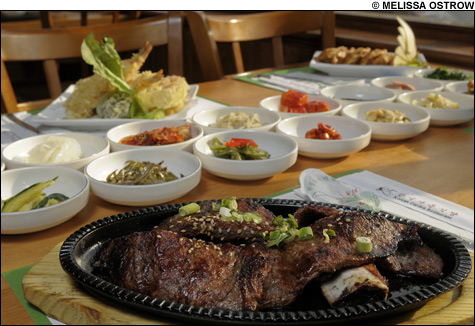
KALBI GUI: These marinated short ribs — here sliced tableside — offer some of the tastiest meat in any cuisine. |
| Korean Garden Restaurant | 122 Harvard Avenue, Allston | 617.562.8989 | Open Sunday–Wednesday, 11:30 am–10 pm; and Thursday–Sunday, 11:30 am–11 pm | Beer and wine | AE, DI, MC, VI | Sidewalk-level access | No valet parking |
Despite being open only six months, Korean Garden already has 22 Internet reviews. The Chowhounds love it and the Yelpers hate it. It's a strange place, not easy to navigate — and one that perhaps best illustrates why professional restaurant critics like myself still have jobs. The takeout menu, for instance, has more than 80 dishes listed, ranging from relatively familiar Japanese food to multi-syllabic Korean items with rather vague English translations. (How do you decide between "Dakdoritang" and "Darokukbop"?) Unless you have a Korean-American guide, or you are one yourself, you need this review.Even looking around can be deceptive at Korean Garden. Side dishes with apparently similar amounts of red pepper vary widely in heat. Menu semiotics are no help, either. "Haemul Jungol" ($39.99), a two-person casserole, is listed as "mixed seafood and vegetables in special broth," for instance. The English-only reader gets only one other clue about whether to invest in one of these, which is a single asterisk for "Hot and spicy." (In fact, this appetizing hot pot with half a lobster on top is so fiery that it would give pause to a Cajun, and would earn at least three asterisks at a Thai restaurant.)
Korean cuisine doesn't do much about appetizers, since each meal comes with "panchan," a constantly changing array of savory pickles and side dishes. These are a strong point for Korean Garden, which puts out seven with lunch and a full dozen with dinner orders.
The dinner panchan includes three kinds of kimchee (napa cabbage, cucumber, and zucchini), all more spicy than fermented, with the nod going to the crunchy cucumber. There's also baby octopus tendrils; lotus root braised to the consistency of chocolate; dried shrimp; hot dogs sliced with a few scallions (must be very exotic in Korea); dried tiny fish (another favorite, not fishy at all); pickled bean sprouts; black beans in a sweet confection; daikon chunks powdered with very hot red pepper (surprisingly popular); and fresh, crisp pickled onions.
That's a lot of food, so if you still want appetizers you might as well go Japanese — the dry-fried shrimp tempura ($8.99) led our list. "Shumai" ($4.99) here are the Japanese-style wrapped shrimp/pork dumplings that look like six bay scallops. Seaweed salad ($5.99) has the usual sesame-soy dressing, but the portion is large. Our server, since we had ordered lots of seafood, added a complimentary fried smelt — not on the menu — and it was remarkably delicious. The lone Korean appetizer we sampled, "Haemul Pajin" ($9.99), was an eggy squid-and-scallion pancake, and greasier than some.
The marinated short ribs in "Kalbi Gui" ($20.95) was by far the best entrée; this is some of the tastiest meat in any cuisine. While this dish was rather expensive, the waiter sliced the plentiful beef off the bone tableside. "Bulgoki" ($18.95), though listed as barbecue, is actually shaved steak braised in soy sauce, such as would be served over "Japchae" ($15.99), a beef and cellophane-noodle dish that is another easy point of entry to Korean food. You'll like the Bulgoki, but you'll love the Kalbi.